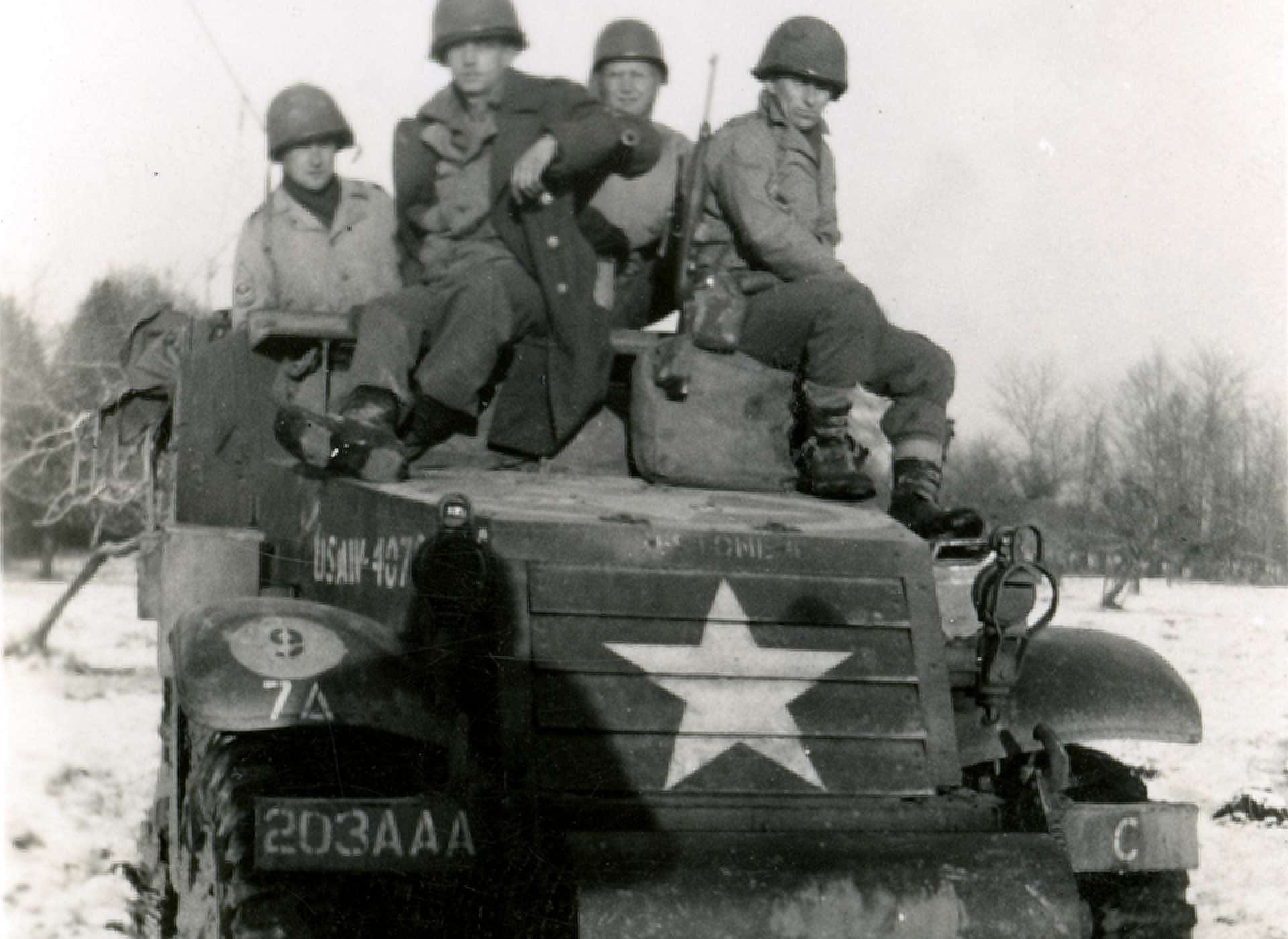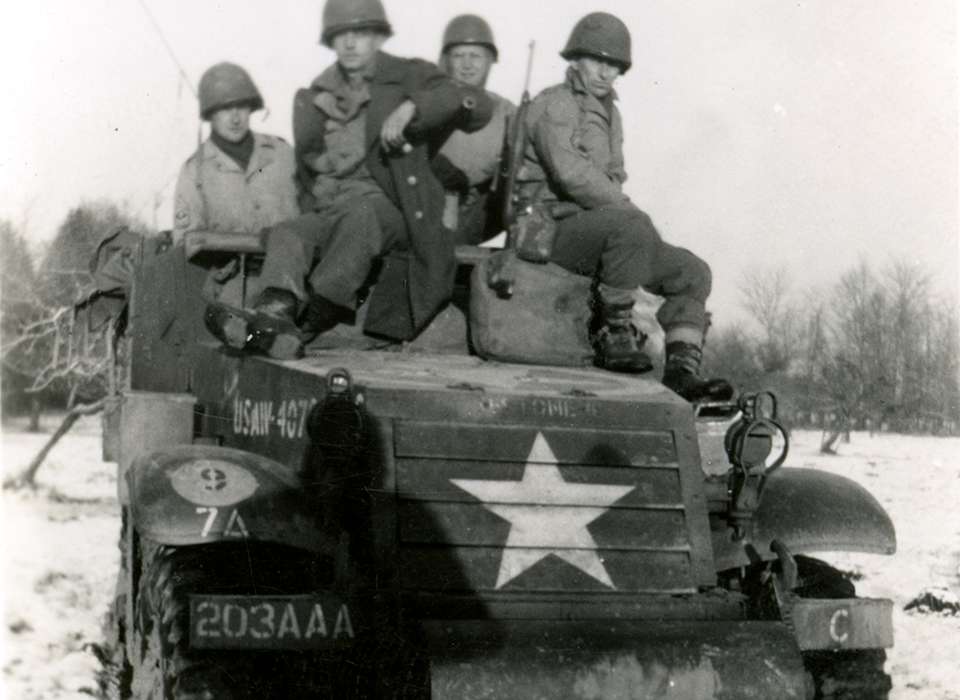As 1944 was drawing to a close, the Allied forces could look back on a year of great strides towards victory over the Axis powers. In Europe, the successful D-Day landings had given way to the liberation of France and Allied forces now were into Holland and Belgium, poised along the German border.
A sense of overconfidence began to infect the Allied leadership, where some even predicted that the war would be over by Christmas. Even though the Allied advance had slowed in the Hurtgen Forest and Vosges mountains, there was still the sense that the war was nearly won and ultimate victory was very near as the year drew to a close.
Adolf Hitler had other plans. The Germans were secretly massing an attack force under cover of night and radio silence. Hitler recognized a potential opportunity to pull German victory out of the Allies grasp with a last roll of the dice: he would launch a winter offensive through a weak point in the Allied lines in the Ardennes, drive to Antwerp in Belgium, taking the port city and splitting the British army to the north from the American army in the south.
The Germans could then methodically destroy the Western armies. Hitler believed he could exploit the unease between the Anglo-Americans and the Soviets to achieve a negotiated peace with the US and Britain which not only would preserve the Nazi regime, but allow him to concentrate solely on the war on the eastern front.
These were the stakes when the Germans launched their surprise attack through Belgium on December 16, 1944. Some of the first Americans to confront Hitler’s gamble on the front lines were the men of the 394th Infantry Regiment at Lanzareth Ridge. Eighteen men put up devastating fire against the first attack of over 500 German paratroopers. “It was kind of like a manslaughter,” remembered platoon leader Lyle Bouck.
The element of surprise and the strength of the Germans were overwhelming. On the third attack, Bouck and his men were captured. “I felt like what I did was a failure,” Bouck declared many years afterward. This was despite the fact that his platoon had held up the spearhead of Kampfgruppe Peiper of the 1st SS Panzer Division, preventing a force of over 5,000 men from advancing for eight crucial hours, a feat which would later make the platoon the most decorated in US Army history.
It would be hours before the Allies realized the German offensive was more than a feint, and not all were so lucky to share the fate of Lyle Bouck, now a German POW. The next day at Malmedy, Belgium, Kampfgruppe Peiper overtook a group of Americans from the 285th Field Artillery Observation Battalion and rounded the prisoners into a field.
“We were in a group and just standing there with our hands up. And every tank and half track that came around just fired in the group. And everybody started dropping. I dropped and could hear guys praying and maybe I was too, you know? And anyone that was moaning or something, they came around and fired at the ones that were moaning,” recalled survivor Ted Paluch. The Malmedy Massacre saw over 80 men murdered in one of the most brutal war crimes committed against American troops in Europe.
These two incidents, featuring heroism and brutality, set the stage for what was to come in the next six weeks of battle. The German attack famously “bulged” the Allied lines. Fierce Allied resistance along the northern shoulder of the Elsenborn ridge denied the Germans the northern roads they needed for success. In the center, the Allied defenders at the vital crossroads town of St. Vith fought ferociously and delayed the German timetable for advancement there by nearly a week.
In the south, the spirit of resistance was enshrined at the besieged and surrounded town of Bastogne, when Brigadier General Anthony McAuliffe answered the German demand to surrender with a one-word reply: “NUTS!” The US 3rd Army’s drive to relieve Bastogne cast a legendary aura around these events; with over 600,000 American troops participating, it remains the largest battle ever fought by the US Army in its history.
In the end, the Allied lines bulged but did not break, and drove the Germans back towards their homeland and the final stages of the war. Hitler would have no chance again to win the war. But successfully denying Hitler’s last gamble came at a high cost.
In the Battle of the Bulge, between December 16, 1944 and January 25, 1945 the United States suffered well over 80,000 casualties, including an official Army count of 19,246 dead and more than 23,000 American troops taken prisoner.

Four American soldiers riding on a half-track during the Battle of the Bulge. The National WWII Museum, Gift of John J. Janik Family, 2013.297.258.
It is a sobering reality and testament to the scale of the struggle to realize that the Battle of the Bulge accounts for approximately 10 percent of all American combat casualties in World War II.
Keith Huxen
Keith is the former Senior Director of Research and History in the Institute for the Study of War and Democracy at The National WWII Museum.
Cite this article:
MLA Citation:
APA Citation:
Chicago Style Citation:





![Max Fuchs, New York City cantor, sings as Rabbi Sydney [sic] Lefkowitz, Richmond, VA, conducts the first Jewish services from Germany.](/sites/default/files/styles/max_650x650/public/2025-10/image1.jpg)



